几个高中英语语法难点的用法及相互联系
- 格式:doc
- 大小:14.00 KB
- 文档页数:2
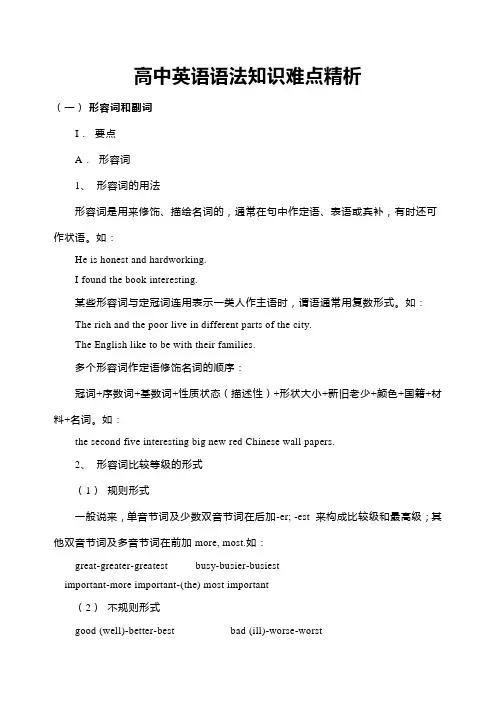
高中英语语法知识难点精析(一)形容词和副词I.要点A.形容词1、形容词的用法形容词是用来修饰、描绘名词的,通常在句中作定语、表语或宾补,有时还可作状语。
如:He is honest and hardworking.I found the book interesting.某些形容词与定冠词连用表示一类人作主语时,谓语通常用复数形式。
如:The rich and the poor live in different parts of the city.The English like to be with their families.多个形容词作定语修饰名词的顺序:冠词+序数词+基数词+性质状态(描述性)+形状大小+新旧老少+颜色+国籍+材料+名词。
如:the second five interesting big new red Chinese wall papers.2、形容词比较等级的形式(1)规则形式一般说来,单音节词及少数双音节词在后加-er; -est 来构成比较级和最高级;其他双音节词及多音节词在前加more, most.如:great-greater-greatest busy-busier-busiestimportant-more important-(the) most important(2)不规则形式good (well)-better-best bad (ill)-worse-worstmany (much)-more-most little-less-least(3)形容词比较等级的用法①表示两者的比较,用形容词的比较级+than. 如:He is cleverer than the other boys. This one is more beautiful than that one.②表示两者以上的比较,用"the +形容词最高级(+名词)+of(in) …"如:He is the cleverest boy in his class.③表示两者是同等程度,用"as +形容词原级+as". 如:He is as tall as I. I have as many books as you.④越… 越…例如:The more I learn, the happier I am.⑤ You can never be too careful. 越小心越好又如:You can never praise the teacher too highly.你怎么赞扬这个老师也不过分。
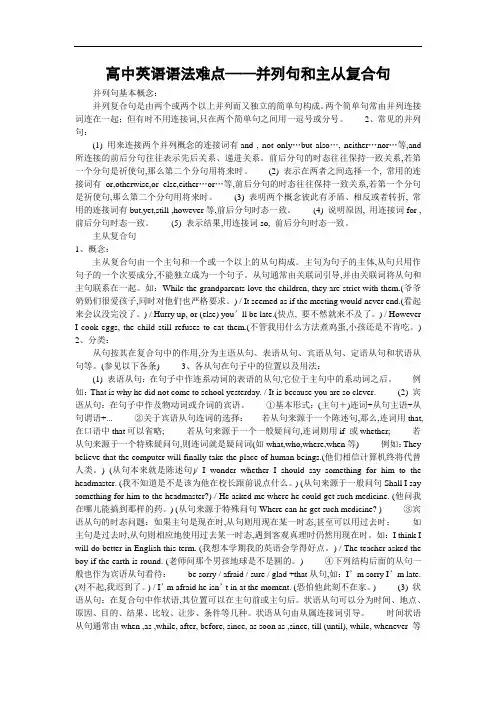
高中英语语法难点——并列句和主从复合句并列句基本概念:并列复合句是由两个或两个以上并列而又独立的简单句构成。
两个简单句常由并列连接词连在一起;但有时不用连接词,只在两个简单句之间用一逗号或分号。
2、常见的并列句:(1) 用来连接两个并列概念的连接词有and , not only…but also…, neither…nor…等,and 所连接的前后分句往往表示先后关系、递进关系。
前后分句的时态往往保持一致关系,若第一个分句是祈使句,那么第二个分句用将来时。
(2) 表示在两者之间选择一个, 常用的连接词有or,otherwise,or else,either…or…等,前后分句的时态往往保持一致关系,若第一个分句是祈使句,那么第二个分句用将来时。
(3) 表明两个概念彼此有矛盾、相反或者转折, 常用的连接词有but,yet,still ,however等,前后分句时态一致。
(4) 说明原因, 用连接词for ,前后分句时态一致。
(5) 表示结果,用连接词so, 前后分句时态一致。
主从复合句1、概念:主从复合句由一个主句和一个或一个以上的从句构成。
主句为句子的主体,从句只用作句子的一个次要成分,不能独立成为一个句子。
从句通常由关联词引导,并由关联词将从句和主句联系在一起。
如:While the grandparents love the children, they are strict with them.(爷爷奶奶们很爱孩子,同时对他们也严格要求。
) / It seemed as if the meeting would never end.(看起来会议没完没了。
) / Hurry up, or (else) you’ll be late.(快点, 要不然就来不及了。
) / HoweverI cook eggs, the child still refuses to eat them.(不管我用什么方法煮鸡蛋,小孩还是不肯吃。
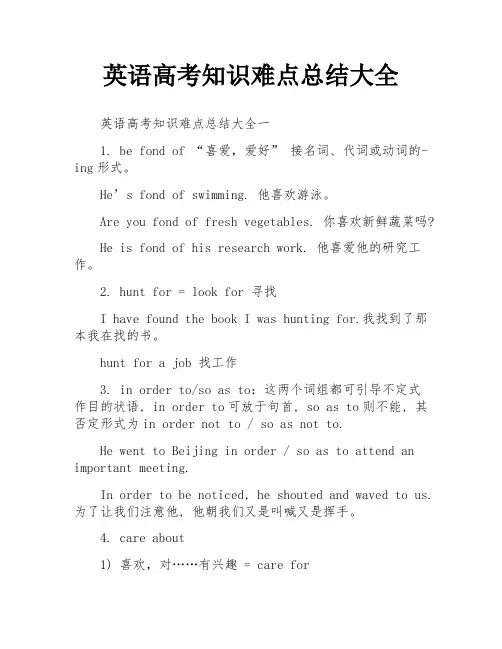
英语高考知识难点总结大全英语高考知识难点总结大全一1. be fond of “喜爱,爱好” 接名词、代词或动词的-ing形式。
He’s fond of swimming. 他喜欢游泳。
Are you fond of fresh vegetables. 你喜欢新鲜蔬菜吗?He is fond of his research work. 他喜爱他的研究工作。
2. hunt for = look for 寻找I have found the book I was hunting for.我找到了那本我在找的书。
hunt for a job 找工作3. in order to/so as to:这两个词组都可引导不定式作目的状语, in order to可放于句首, so as to则不能, 其否定形式为in order not to / so as not to.He went to Beijing in order / so as to attend an important meeting.In order to be noticed, he shouted and waved to us.为了让我们注意他, 他朝我们又是叫喊又是挥手。
4. care about1) 喜欢,对……有兴趣 = care forShe doesn’t care about money.她不喜欢钱。
2)关心 = care forShe thinks only of herself. She doesn’t care about other people.她只考虑自己。
她不关心别人。
3)在乎,在意(接从句或不接任何成分)These young people care nothing about what old people might say.这些年轻人根本不在乎老人说的话。
5. such as 意为“诸如……”,“像……”,是用来列举人或事物的。
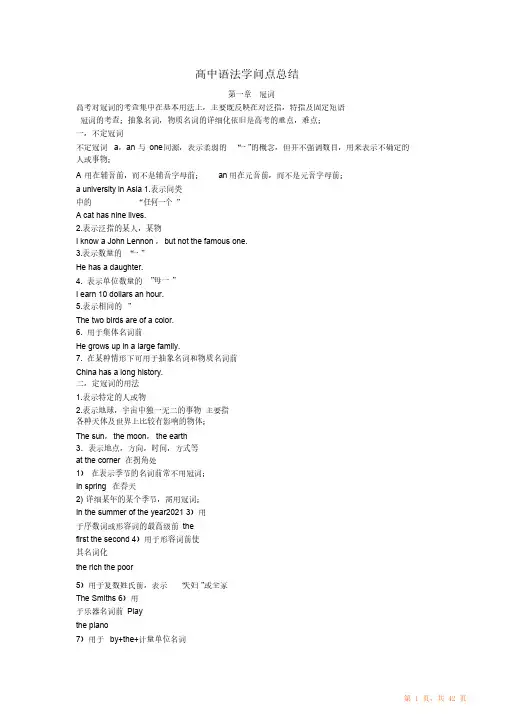
高中语法学问点总结第一章冠词高考对冠词的考查集中在基本用法上,主要既反映在对泛指,特指及固定短语冠词的考查;抽象名词,物质名词的详细化依旧是高考的重点,难点;一,不定冠词“一”的概念,但并不强调数目,用来表示不确定的不定冠词a,an 与one 同源,表示柔弱的人或事物;an 用在元音前,而不是元音字母前;A 用在辅音前,而不是辅音字母前;a university in Asia1.表示同类中的“任何一个”A cat has nine lives.2.表示泛指的某人,某物I know a John Lennon ,but not the famous one.3.表示数量的“一”He has a daughter.4. 表示单位数量的”每一”I earn 10 dollars an hour.5.表示相同的”The two birds are of a color.6. 用于集体名词前He grows up in a large family.7. 在某种情形下可用于抽象名词和物质名词前China has a long history.二,定冠词的用法1.表示特定的人或物2.表示地球,宇宙中独一无二的事物主要指各种天体及世界上比较有影响的物体;The sun,the moon,the earth3.表示地点,方向,时间,方式等at the corner 在拐角处1)在表示季节的名词前常不用冠词;In spring 在春天2) 详细某年的某个季节,需用冠词;In the summer of the year20213)用于序数词或形容词的最高级前thefirst the second4)用于形容词前使其名词化the rich the poor“夫妇”或全家5)用于复数姓氏前,表示The Smiths6)用于乐器名词前Playthe piano7)用于by+the+计量单位名词By the pound1. 用于复数名词前复数名词泛指某类人或物时,其前通常用零冠词;Students should obey the school rules. 同学应当遵守校规;复数名词如需特指,就要加定冠词;The students are too lazy. 这些同学太懒;2. 用于不行数名词前不行数名词表示泛指时,其前通常用零冠词;如:Bread is made from flour. 面包是用面粉做的;Wood is a poor conductor of sound. 木头是声音的不良导体;不行数名词如需特指,就要加定冠词;He sawed the wood into three pieces. 他把木头锯成三块;3.用于专出名词前在通常情形下,专出名词前要用零冠词;如:Mr Smith is our English teaches us English. 史密斯先生教我们英语;在特殊情形下,如专出名词需要特指,也可加定冠词;如:The Smith you ’re looking for no longer lives here.4. 用于抽象化的可数名词前有些可数名词抽象化后表示表示的活动,其前通常零冠词;Jim has gone to bed. 吉姆已上床睡觉了;She goes to church every Sunday. 她每周星期天都去做礼拜;这类主要涉及bed, church, class, college, school, university, work, hospital, prison, market, sea, town 等;另外,这类名词前用不用冠词有时与英美英语的表达习惯有关;如:“住院”在英国英语中通常说成in hospital ,而在美国英语中就通常说成in the hospital ;类似的仍有go touniversity ( 英)上高校在吃饭;5. 用于职务及头衔前/ go to the university ( 美)上高校;at table (英)在吃饭/ at the table (美)当表示职务及头衔的名词用作表语,补足语及同位语时,其前通常用零冠词;如:Wilson became President of the U. S. A. 威尔逊当了美国总统;He will be made captain of the football team. 他将被选为足球队队长;6. 在表示学科,语言,三餐,月份,季节,节假日,星期等名词前,通常用零冠词;我们大家都对物理感爱好;We are all interested in physics.7. 用于某些固定结构中go to sea 去当水手at night 在晚上at most 至多at last 最终on foot 步行at home 在家at least 至少第一at firstin bed 在床上face to face 面对面其次章代词高考中对代词的考查主要集中在人称代词(主要是其中的代词上;it),关系代词,指示代词和不定一,it 的用法1.作人称代词John likes playing Ping pong ./ He always does it in the afternoon .(指代上下文提到的事物);/It's time we went home. / How far is it from here to your home . / It is getting warmer and warmer./ It's very quiet at the moment .(可指时间,天气,环境等)2.引导词A .作形式主语,代替由不定式,动名词或从句表示的真正主语;It's important for us to learn a second language ./ It's no use talking to him ./ It's known to all that the earth goes round the sun.B.作形式宾语,代替由不定式,动名词或从句表示的真正宾语;We feel it our duty to help others ./ He made it clear that he would leave the city .C.强调结构:It is (was) + 被强调部分+that ( 或who)其后的连接词也绝不能为when 留意:在强调结构中,如被强调部分为时间状语或地点状语,或where,而应用that ;在复习中,肯定要留意句式的不同;It was in Shanghai that I bought the guitar .(that 引起强调句)It was Shanghai where I bought the guitar .(where 引起定从)It was twelve o'clock when we arrived there .(when 引起时间状语从句)It was at twelve o'clock that we arrived there .(that 引起强调句)3. it,one,that 的区分:作为代词,这三个词的对比使用是高考的热点之一;—Why don't we take a little break. —Didn't we just have .A .it B.that C.one D.thisThe Parkers bought a new house but will need a lot of work before they can move in .A .they B .it C.one D .whichthat 特指性强,指代可数与不行数词,而it 指代上文提过one 用以指代同类事物中的任一,的同一事物;二,关系代词who,whose,whom,which,that,as1)which 可以引导非限定性定语从句,代表前面整个句子的内容,并且在从句中做主语2)that 的用法1)不用that 的情形a) 在引导非限定性定语从句时;b) 介词后不能用;We depend on the land from which we get our food.We depend on the land that/which we get our food from.2) 只能用that 作为定语从句的关系代词的情形a) 在there be 句型中,只用that,不用which ;等作先行词b) 在不定代词,如:anything, nothing, the one, all, much, few, any, little时,只用that,不用which;c) 先行词有the only, the very 修饰时,只用that;that;.d) 先行词为序数词,数词,形容词最高级时,只用e) 先行词既有人,又有物时;举例:All that is needed is a supply of oil.所需的只是供油问题;Finally, the thief handed everything that he had stolen to the police.那贼最终把偷的全部东西交给了警察;as 的用法3)AS 作关系代词,用来引导定语从句一,AS 引导限制性定语从句: 限制性定语从句和限非制性定语从句AS 引导限制性定语从句时,通常和such, the same, as(so)等连用,构成such...as/such as, thesame...as/the same as, as(so)...as等结构,在从句中可作主语,宾语和表语;1.such...as/such as意为“.的.. 那种...,像那样的”,such...as/such as引导限制性定语从句时, )既可指人,也可指物;such 用于名词之前时时,具有代词性质;,具有形容词性质;such 单独使用(即后面不接名词Don’t trust such men as praise you to your face.(as作主语)不要信任那种当面吹捧你的人;You should read only such books as you can understand without much difficulty.(as 作宾语你应当只读那些你读起来不太难懂的书;Associate with such as will improve your manners.(as 作主语)要和能改善你的言行的那种人结交;)2.the same...as/the same a s意为“与...同样的”和, such一样,the same既有形容词作用代词性质;We have arrived at the same conclusion as they have.(as 作宾语)我们已得出和他们同样的结论;比较:the same...as和the same...that 不同,前者是“同那一个相像”后,者是“正是那一个如:This is the same watch as I lost.这同我丢的那块表一样;,又有”;这正是我丢的那块表;3.as(so)...as意为“和...一样”后,接由many, much等修饰的名词或由形容词修饰的单数名词,留意其语序为as(so)+adj.+a+n+as,如:It ’s as pleasant a film as I have ever seen.这是一部和我以往看的同样好的电影;As many soldiers as marched were killed.许多游行的战士都被杀了;留意:such ...as 与such...that ,so...as与so...that 的区分: that 是连词,引出结果状语从句,在从句部分不作成分;as 是关系代词,引出定语从句,在从句中可作主语,宾语和表语;比较: He is such a nice boy that everyone likes him.He is such a nice boy as everyone likes.It is so difficult a problem that nobody can work it out.It is so difficult a problem as nobody can workout.二,AS 引导非限制性定语从句AS 引导非限制性定语从句时,通常指的不是主句中的某一个名词(先行词),而是指整个主句表达的内容,对主句所作的陈述进行附加说明,意为“这...,如...或正如... ;”这种从句可位于主句之前,之中或之后;As we all know, Taiwan belongs to China.Taiwan, as we all know, belongs to China.Taiwan belongs to China, as we all know.留意下面的习惯用法:as is well discussed 正如已争论过的as is often said 正如通常所说as is often the case 通常就是这样as has been pointed 正如所指出的那样as has been said before 如上所述as often happens 犹如常常所发生的那样as might be expected 正如所料as is well known to all 众所周知在多数情形下,从句中的谓语助动词可以省略as explained before 如前面所说明的as mentioned above 如前面所提到的as shown in the figure 如下列图as seen from the table 从表中可以看出as already discussed 正如已争论过的三,不定代词一). some 与any 的用法1. some 用于确定句以及表示建议或期望得到确定回答的问句;修饰单数名词时,意为某个;如:I have some questions about the assignment.(期望得到确定答复);表示一些;用于确定句时,只和单数名词或不行数名词连用,2. any 用于否定句和疑问句时,表示任何;如:‘s.The medicine is on sale every where. You can get it at any chemist二). each 与every 的用法1. each 强调个体,表示两个或两个以上中的每一个,在句中可充当主语,宾语,定语和同位语;如:There are trees and flowers at each side of the road.every of them ,2. every 强调整体,表示三者或三者以上中的每一个,只能作定语,不能说要说every one of them .Every student in our class works hard.三. no one 与none 的用法of 连用,谓语动词用单数形式,1. no one 意为没有人,只能指人,不能指物,不行与介词回答who 引导的问句;如:Who is in the classroom ?No one.2. none 既可指人,也可指物,强调数量,意为一点也不,一个也不;谓语动词既可用单数也可用复数;常与of 连用,通常指三者以上的人或物中没有一个,回答how much 和how many 引导的问句;如:They were all tired ,but none of them would stop to have a rest.四. other,another,others,any other,the other 的用法1. other 表示泛指,意为另外的,其它的;常与复数名词或不行数名词连用;假如其前有the,this,some,any,each,every,no,one 以及形容词性物主代词时,其后就可接单数名词;如:I have no other place to go.2. another 常用于指三者或三者以上中的另外一个,假如其后接复数名词,就表示又,再,仍;如:泛指单数;可单独使用,也可后接名词;This cap is too small for me. Show me another (one);We need another three assistants in our shop.3. others :它是other 的复数形式,表示泛指,意为别的人或物,但不指全部;特指时在其前加定冠词;前面可加任何限定词以及数量词;如:He has more concern for others than for himself.4. any other 表示一个之外的其他任何一个,而不是两个之中的另一个;如:China is larger than any other country in Asia.5. the other :表示两者中的另外一个;可单独使用,也可接单数名词;如:No agreement was reached in the discussion as neither side would give way to the other.五. all 与均表示都,both 的用法但all 表示三者以上的人或物,both 就表示两个人或物;二者都表示确定意义,假如与not 连用时,就表示部分否定;六. neither 与either 的用法都可用于表示两个人或物;neither 表否定意义,意为(两者中的每一个)都不;而either 表确定意义,意为(两者中的每一个)都;都可单独使用,也可同介词Both teams were in hard training ;neither willing to lose the game.Do you want tea or coffee ?of 连用;如:.‘t mindEither. I really don第三章形容词和副词高考对形容词和副词的考查主要集中在对形容词和副词的辨析上,同时加大对比较级的考查一,形容词1)多个形容词修饰名词的排列次序限定词(包括冠词,全部格,人称代词,指示代词,数量词等)+表示观点的词(品质,状态,即表示好坏美丑等的词种类+用途+名词)+大小或长短+年龄或新旧+外形或样式+颜色+产地或来源+材料或a nice long new black British plastic pen2)形容词作状语,表相伴或结果He returned,safe but tired.3)复合形容词的用法1)形容词2) 形容词3)形容词+ 名词+ ed+ 形容词+ 现在分词现在分词过去分词kind-hearted 好心的,white-haired 白发的red-hot 酷热的,dark-blue 深蓝的good-looking 好看的,easy-going 随和的4)副词5)副词hard-working 勤劳的,hard-won 得来不易的,fast-moving 快速转动的newly-made 新建的++6)名词 7)名词 8)名词 9)数词 10) 数词 二, 形容词 现在分词 过去分词 名词 + ed life-long 终生的, world-famous 世界著名的+ + + + peace-loving 爱好和平的, snow-covered 白雪掩盖的, fun-loving 爱开玩笑的hand-made 手工的four-storeyed 4 层楼的, three-legged 3 条腿的+ 名词 (名词用单数 ) ten-year 10 年的, two-man 两人的形容词和副词比较级和最高级的用法一,比较级和最高级的常见结构1. “ th e 比+较级 , the +比较级 “:表示 “越 越 ”The sooner you see a doctor, the better it is. 你越早看医生越好;2. the +序数词 +最高级 +单数可数名词:表示 “第几大的 ”This is the third most popular song of Michael Jackson ;这是迈克尔 ·杰克逊第三受欢迎的歌曲;二,比较级和最高级的修饰语1.常见的比较级的修饰语有: rather, any, (far) larger thanThis movie is far more interesting than I expected. 这部电影比我原想的有意思的多;2. all the + 比较级:愈来愈I worked all the harder. 我工作愈来愈努力了;much, a little, a great deal, far, by far, even, will, still, a bit, a little, 3.常见的最高级的修饰语有:序数词, 等He is almost the best player. 他基本上是最好的选手;4. any 修饰比较级只用于疑问句,否定句和条件状语从句Can you do any better on this job. 你这件事情能不能做得更好些 三,表达倍数的常用结构1.数词 +times+as+ 形容词原级 +asThis room is twice as big as that one. 这房间的面积是那间的两倍;2.数词 +times+ 形容词比较级 +thanby far, nearly, almost, by no means, not quite, not really .This room is twice bigger than that one. 这房间的面积是那间的两倍;3.数词 +times+ 性质名词 +of ( 性质名词主要有: 等)length, size, height, weight, depth This room is twice the size of that one. 这房间的面积是那间的两倍;4. (not)half+as+ 形容词原级 +asThis room is half as big as that one. 这房间的面积是那间的一半;四,比较级与冠词的搭配1.不含 than 的比较级前可加不定冠词修饰,构成 “ a/an 比+ 较级 +单数可数名词”表示 “一个 更 的人 /物 ”; Why don ’ t you use a sharper knif e 你. 为什么不用一把更锐利的刀呢 .2.被比较者被明确特指时,比较级前面应当加定冠词 “ th e 修”饰; Which is the younger one, Lily or Lucy. 哪一个年龄小一些,莉莉仍是鲁西 五,比较级和同级比较.1. as +原级 + as : 和 一样The room is as big as that one.这间房子和那间一样大;2. as many/much/far/long as + 详细数词:到达某种程度The number of the students in that school reaches as many as 4,000.那所学校的同学数量多达 4ooo 人;a 中s 间出名词时采纳以下格式: 3. as 1) as +形容词 + a/an +单数名词 +asHe is as kind a person as his father.他和他爸爸一样都是和善的人;2) as + many/much+ 不行数名词 /可数名词复数 +asI can carry as much paper as you can.你能搬多少纸,我也能;I have as many books as you do.我的书和你的一样多; 六,关于比较级,最高级的几个高频考点1. most 前如没有 the ,就没有比较的意思,只是加强语气,有 This is a most interesting story ;2. 比较级 +than any otherShe is taller than any other girl in her class ;“很,特别 ”之意;never 比+较级 ,not ever 比+较级3. I have never heard a better voice than yours ;比+较级 +thanNothing is more precious than time ;没有比时间更宝贵的;第四章系动词的用法1. 最常用连系动词:2. 表变化的系动词: 词一般只有一般现在 be(am; is/was; are/were);get; turn; go; fall; become; grow; come; run 时和一般过去时两种时态变化形式, ;用法留意:在英语中,系动 没有其他时态变化形式; 但表 变化的这类系动词除外,它们有各种时态变化;E.g.: It is becoming colder and colder.The food has gone bad.此处仍需留意的是 become 和 turn 后接表职业的名词时冠词的有无:E.g.: Two years later, he became a teacher.但 Two years later, he turned teacher.另外, go 表变化时一般指事情向消极,不好的方面转化;3. 所谓 “感官动词 ” :look; sound; taste; smell; f e e ;l 一般它们在句子中译成: 上去;此类系动词为高考高频词;E.g.: The food tasted good. 食物尝起来很香;;;;起来; ;;; 其中必需留意到它们本身也用作实义动词,所以在平常的教学和应用中肯定多比较,关注它们的用法;E.g.: He looked sadly at the picture. / She looked sad after hearing the news.Tom tasted the food and it tasted good.4. 表状态的系动词: keep; stay; remain; (依旧是;保持)E.g.: She remains loyal to her father despite his cruelty towards her.What a lovely day today. I love fine weather and I hope it will stay fine for some more days. Much remains to be done.5. 表像系动词: seem; appear ;汉语意义:看起来像,似乎,似乎;这两个动词有一个共同 的特点,即假如要表达时态的变化,需要后接不定时来完成;E.g.: He seemed to have caught cold./ When Father came in, Tom seemed to be eating something. 另外此处一句型转换也要要求同学牢记It seemed that he had caught cold.When Father came in, it seemed that Tom was eating something.6. 终止系动词:prove; turn out ;表达“证明,证明,结果为;;;E.g.: He proved (to be) right. / The experiment turned out successful.系动词用法应留意的几个问题”之意;1.一般地说,系动词无进行时态,无被动语态Your hand feels cold.The soup tastes good.The dinner smells good.2.系动词的时态与形容词的比较级连用的问题;如:某些含有变化意义的动态系动词如级连用,表示渐进过程,其意思是He is growing taller and taller.Our life is getting better and better. Things are getting worse.get, become, grow, turn 等的进行时态可与形容词的比较“越来越”;例如:3.全部半系动词的被动语态要分情形争论;英语中某动词在作系动词用时,无被动语态,而作实义动词用时,才有被动语态,二者不可混为一谈;例如:不能说:The apple is tasted good.由于taste 此时是系动词,质,无被动语态)“尝起来”之意,指的是苹果的性但我们可以说:The apple is tasted by me.这苹果被我尝了一下;(taste 此时指“尝一尝”这一动作,有被动语态)因此,在平常的英语教学和学习之,要有意留意半系动词在详细的语言环境中到底是系动词用法仍是实义动词用法,要留意区分,识别;4.瞬时动态系动词能否与时间段连用的问题英语中某些表示瞬时意义的系动词不能与+ 时间,so far 等”直接连用;例如:“for+时间段,since+时间点,how long until+时间,by①不能说:He has become a teacher for 2 years.应改为:He has been a teacher for 2 years.②不能说:He has turned writer since 3 years ago.应改为:He has been a write since 3 years ago.或It is two years since he turned writer.③不能说:He got angry until his child came back home.应改为:He didn ’t get angry until his child came back home.5.系动词能接几种表语(从句)系动词除了接adj.\n.\prep. 短语,仍可接以下几种表语形式:①能接as if/as though 表语从句的系动词有:look(看起来),smell(闻起来),sound(听起来),feel(觉得);appear(显得),seem(似乎);例如:It looks as if we are going to have snow. 看样子天要下雪了;He looked as if he had just stepped out of my book of fairy tales. 他看来似乎刚从我的童话故事 中走出来似的;’ t understand why Laur 看a 来w a 她s 好th e 像r e 不. 能懂得为She seemed as if (though) she couldn 什么劳拉呆在那儿; tap run ’nin s g asomewhere. 我似乎听到某处水龙头流水的声音; It sounds to me as though there She felt as if her head were splitting. 她似乎觉得她的头要裂开了;The river appeared as if enveloped in smog. 那条河似乎掩盖在烟雾之中;It seems as if it were spring already. 似乎已是春天了;②可用于 “It+系动词 +that 从句 ”结构的有: seem, appear 如:It seemed that he had made some serious mistakes in his work. 似乎他在工作中犯了严峻错误; It appeared that he was talking to himself. 似乎他在自言自语;③能用不定式作表语的系动词有: be, seem, , look, appear, prove, grow.Her job is to look after the children. 她的工作是照管孩子们;He seems not to look after the children. 他似乎不是她的父亲;He looks to be a young girl of twenty. 他看起来像是一个 He didn ’a t p pear to dislike it. 看不出他憎恨此事;My advice proved to be wrong. 我的建议证明是错误的;20 岁的年轻姑娘;④能与 there 连用的系动词有: be, appear, seem.There appeared to be only one room. 那儿似乎只有一个房间;There seems(to be)no need to go.似乎没有必要走第五章 动词的时态和语态1,动词时态考查要点简述(1)一般现在时考点分析①表示客观事实或一般真理(不受时态限制)The geography teacher told us the earth moves around the sun.②表示现状,性质, 状态时多用系动词或状态动词;表示常常或习惯性的动作,多用动作动 词,且常与表频率的时间状语连用;Ice feels cold.We always care for each other and help each other.③表示知觉,态度,感情,某种抽象的关系或概念的词常用一般现在时: taste , feel , notice , agree , believe , like , hate ,want , thinkbelong seem 等;如:I know what you mean.see ,hear , smell , Smith owns a car and a house. All the students here belong to No.1 Middle School.④在时间,条件状语从句中常用一般现在时代替将来时;但要留意由 if 引导的条件状语从 句中可以用 shall 或 will 表 “意愿 ”,但不表示时态;假如你情愿接 If you will accept my invitation and come to our party, my family will be pleased. 受并参与我们的舞会,我的家人会特别兴奋;⑤少数用于表示起止的动词如 come ,go ,leave ,arrive ,fly ,return ,start ,begin ,pen ,close , end , stop 等常用一般现在时代替将来时,表示一个按规定,方案或支配要发生的动作;当 be 表示依据时间或事先支配,确定会显现的状态,只用一般现在时;The shop closes at 11:00 p.m. every day.Tomorrow is Wednesday.(2)一般过去时的考点分析(考核重点);①一般过去时的基本用法: (或有上下文语境示意) 事通常用过去式;如:表示过去的事情, 动作或状态常与表示过去详细的时间状语连用 ;用于表达过去的习惯; 表示说话人原先没有料到,想到或期望的 I met her in the street yesterday.②假如从句中有一个过去的时间状语, 词连用过去式;如:尽管从句中的动作先于主句发生, 但从句中的谓语动 He told me he read an interesting novel last night.③表示两个紧接着发生的动作, 常由以下词语连接, 用一般过去时; 如:but, and, when, as soon as, immediately, the moment, the minute ;The moment she came in, she told me what had happened to her.④常用一般过去时的句型:Why didn ’ t you / I think of that.I didn ’ t notice it.I forgot to tell you I had been there with my brother before.I didn ’ t recognize him.(3)一般将来时考点分析;①表示将来的动作或状态常用 tomorrow , next week 等);②表示一种趋向或习惯动作;We ’ ll die without air or water.will / shall + 动词(常与表示将来的时间状语边用如③表示趋向行为的动词如 come ,go ,start ,begin ,leave 等词常用进行时的形式表示将来时; ④be going to 与 will / shall, be to do, be about to do be going to 表示现在准备在最近或将来要做某事, 用法及区分:这种准备往往经过事先考虑, 甚至已做了 某种预备; shall / will do 表示未事先考虑过,即说话时暂时作出的打算;be going to 表将来,不能用在条件状语从句的主句中;而 will 就能,表意愿;如:’ ll go 正f i 确shi)n g.( If it is fine, we If it is fine, we are going to go fishing.( 错误 )be to do sth.表按方案,支配即将发生的动作,仍可表示嘱咐,命令,禁止,可能性等;’ clock this afternoon.A meeting is to be held at 3:00 o be about to do sth.表示 “即可,就要 ”,后面不能接时间状语或状语从句;Autumn harvest is about to start.(4)现在进行时考点分析;①表示说话时正在发生着的一个动作; 表示现阶段但不肯定是发生在讲话时; 表近期特定的 支配或方案; go , come 等起止动作可用进行时代替将来时;如:It is raining now.He is teaching English and learning Chinese.I am meeting Mr. Wang tonight.We are leaving on Friday.At six I am bathing the baby.(I start bathing the baby before six.)The girl is always talking loud in public. ( 与 always ,often 等频度副词连用,表常常反复的行 动或某种感情颜色 )②下面四类动词不宜用现在进行时;(A )表示心理状态,情感的动作: agree, mean, need ;like, love, hate, care, remember, believe, want, mind, wish, (B )表存在的状态的动词: (C )表示一时性动作的动词: appear, exist, lie, remain, seem belong to, depend on ;allow, accept, permit, promise, admit, complete ;( D )表示感 官的动词: see, hear, notice, feel, smell, sound, taste, look ;(5)过去完成时考点分析(考核重点);①常用过去完成时的几种情形:(A )在 by ,by the end , by the time ,until , before , since 后接表示过去某一时间的短语或 从句以前发生的动作;如: By the end of last year, we had produced 20,000 cars. The train had left before we reached the station.(B) 表示曾实现的期望,准备,意图,诺言等;常用 had hoped / planned / meant / intended/ though / wanted / expected 等或用上述动词过去式接不定式完成式表示即: + to have done ;hoped / planned (C ) “时间名词 + before ”在句子中作状语,谓语动词用过去完成时; “时间名词 + ago ”在 句中作状语,谓语动词用一般过去式;如: before. Xiao Hua left school 3 years ago.He said his first teacher had died at least 10 years (D )表示 “一 就 ”的几个句型: Hardly / No sooner / scarcely had + 主语 + 过去分词 + when / than / before + 一般过去时; 如:We had no sooner been seated than the bus started. = No sooner had we been seated than the bus started.②在 before 或 after 引导的时间状语从句中用一般过去时态代替过去完成时;After he (had) left the room, the boss came in.We arrived home before it snowed.(6)过去将来时考点分析;参照一般将来时对比:用 would do ,was / were going to do sth. 表过去将来; come ,go ,leave 等过去进行时表过去将来时; (7)过去进行时考点分析;was / were to do sth. 和 was / were about to do sth.表过去将来;①过去某一时刻正在进行的动作或某一阶段内发生或频繁发生;②某一动作发生时另一动作正在发生, (8)现在完成时考点分析;其中一个在由 when 或 while 引导的时间状语从句中;①现在完成时除可以和 for ,since 引导的状语连用外, 仍可以和下面的介词短语连用: during / in /over the last(past)few years (months, weeks) , in recent years 等;②以下句型中常用现在完成时It is (has been) + 一段时间 + since 从句完)t 成im 时e that+This(That / It)is the first(second This(That / It)is the only 完成+ t 时hat + 从句 + 完成+时thatThis(that / I t)is the best / finest / most interesting ③在时间或条件状语从句中,现在完成时可以代替一般将来时;如:I shall post the letter as soon as I have written it.If you have done the experiment, you will realize the theory better.。
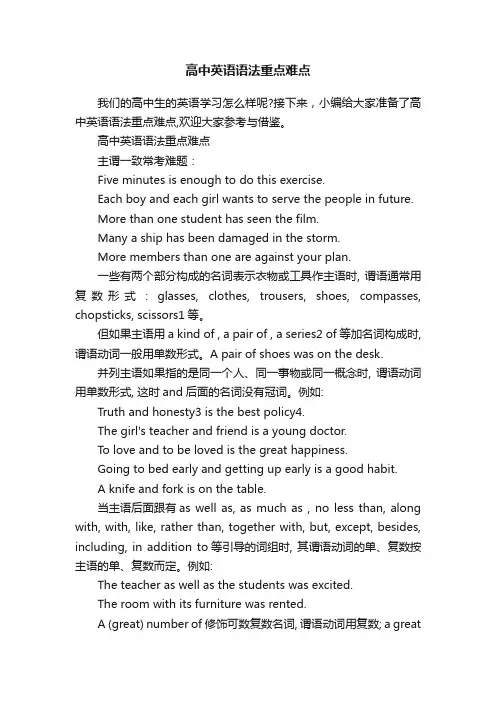
高中英语语法重点难点我们的高中生的英语学习怎么样呢?接下来,小编给大家准备了高中英语语法重点难点,欢迎大家参考与借鉴。
高中英语语法重点难点主谓一致常考难题:Five minutes is enough to do this exercise.Each boy and each girl wants to serve the people in future.More than one student has seen the film.Many a ship has been damaged in the storm.More members than one are against your plan.一些有两个部分构成的名词表示衣物或工具作主语时, 谓语通常用复数形式:glasses, clothes, trousers, shoes, compasses, chopsticks, scissors1等。
但如果主语用a kind of , a pair of , a series2 of等加名词构成时, 谓语动词一般用单数形式。
A pair of shoes was on the desk.并列主语如果指的是同一个人、同一事物或同一概念时, 谓语动词用单数形式, 这时and后面的名词没有冠词。
例如:Truth and honesty3 is the best policy4.The girl's teacher and friend is a young doctor.To love and to be loved is the great happiness.Going to bed early and getting up early is a good habit.A knife and fork is on the table.当主语后面跟有as well as, as much as , no less than, along with, with, like, rather than, together with, but, except, besides, including, in addition to等引导的词组时, 其谓语动词的单、复数按主语的单、复数而定。

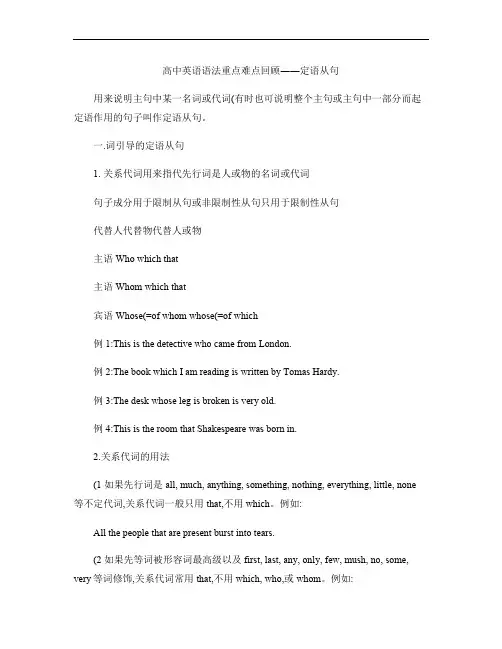
高中英语语法重点难点回顾――定语从句用来说明主句中某一名词或代词(有时也可说明整个主句或主句中一部分而起定语作用的句子叫作定语从句。
一.词引导的定语从句1. 关系代词用来指代先行词是人或物的名词或代词句子成分用于限制从句或非限制性从句只用于限制性从句代替人代替物代替人或物主语Who which that主语Whom which that宾语Whose(=of whom whose(=of which例1:This is the detective who came from London.例2:The book which I am reading is written by Tomas Hardy.例3:The desk whose leg is broken is very old.例4:This is the room that Shakespeare was born in.2.关系代词的用法(1 如果先行词是all, much, anything, something, nothing, everything, little, none 等不定代词,关系代词一般只用that,不用which。
例如:All the people that are present burst into tears.(2 如果先等词被形容词最高级以及first, last, any, only, few, mush, no, some, very等词修饰,关系代词常用that,不用which, who,或whom。
例如:(3 非限制性定语从句中,不能用关系代词that,作宾语用的关系代词也不能省略。
例如: There are about seven million people taking part in the election, most of whom、are well educated. (4 which还有一种特殊用法,它可以引导从句修饰前面的整个主句,代替主句所表示的整体概念或部分概念。
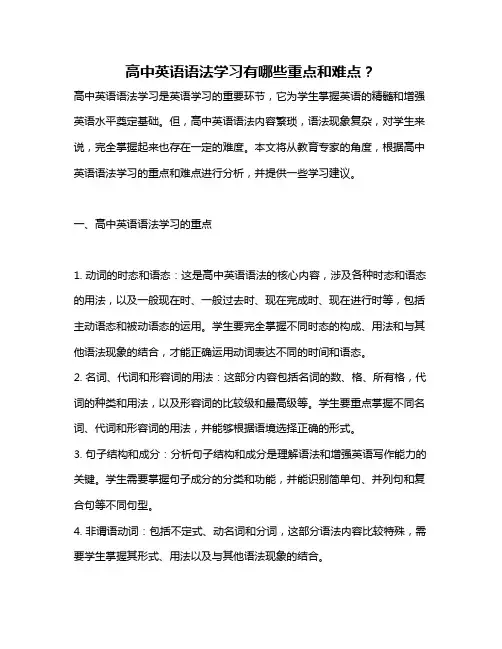
高中英语语法学习有哪些重点和难点?高中英语语法学习是英语学习的重要环节,它为学生掌握英语的精髓和增强英语水平奠定基础。
但,高中英语语法内容繁琐,语法现象复杂,对学生来说,完全掌握起来也存在一定的难度。
本文将从教育专家的角度,根据高中英语语法学习的重点和难点进行分析,并提供一些学习建议。
一、高中英语语法学习的重点1. 动词的时态和语态:这是高中英语语法的核心内容,涉及各种时态和语态的用法,以及一般现在时、一般过去时、现在完成时、现在进行时等,包括主动语态和被动语态的运用。
学生要完全掌握不同时态的构成、用法和与其他语法现象的结合,才能正确运用动词表达不同的时间和语态。
2. 名词、代词和形容词的用法:这部分内容包括名词的数、格、所有格,代词的种类和用法,以及形容词的比较级和最高级等。
学生要重点掌握不同名词、代词和形容词的用法,并能够根据语境选择正确的形式。
3. 句子结构和成分:分析句子结构和成分是理解语法和增强英语写作能力的关键。
学生需要掌握句子成分的分类和功能,并能识别简单句、并列句和复合句等不同句型。
4. 非谓语动词:包括不定式、动名词和分词,这部分语法内容比较特殊,需要学生掌握其形式、用法以及与其他语法现象的结合。
5. 虚拟语气:虚拟语气是英语语法中较难的部分之一,用于表达假设情况和愿望。
学生要重点掌握不同虚拟语气结构的用法,并能够在不同语境中做出正确选择。
6. 固定搭配和习惯用法:英语中有很多固定搭配和习惯用法,这些是英语语言的精髓,需要学生在学习语法的同时进行积累和练习。
二、高中英语语法学习的难点1. 语法现象的多样性和复杂性:英语语法规则繁多,且存在一些例外情况,对学生来说理解和记忆是一大挑战。
2. 语法现象之间的内在关系:不同的语法现象之间通常彼此关联,例如时态与语态,语态与非谓语动词等。
学生需要掌握各个语法现象之间的关系,才能正确理解和运用。
3. 语境对语法的限制:英语语法中有很多规则,但在实际应用中会受到语境的限制,需要学生灵活运用语法知识进行判断。
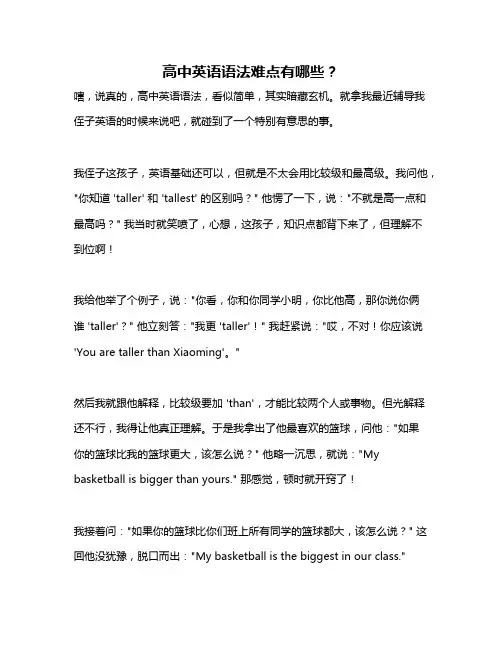
高中英语语法难点有哪些?嗐,说真的,高中英语语法,看似简单,其实暗藏玄机。
就拿我最近辅导我侄子英语的时候来说吧,就碰到了一个特别有意思的事。
我侄子这孩子,英语基础还可以,但就是不太会用比较级和最高级。
我问他,"你知道 'taller' 和 'tallest' 的区别吗?" 他愣了一下,说:"不就是高一点和最高吗?" 我当时就笑喷了,心想,这孩子,知识点都背下来了,但理解不到位啊!我给他举了个例子,说:"你看,你和你同学小明,你比他高,那你说你俩谁 'taller'?" 他立刻答:"我更 'taller'!" 我赶紧说:"哎,不对!你应该说'You are taller than Xiaoming'。
"然后我就跟他解释,比较级要加 'than',才能比较两个人或事物。
但光解释还不行,我得让他真正理解。
于是我拿出了他最喜欢的篮球,问他:"如果你的篮球比我的篮球更大,该怎么说?" 他略一沉思,就说:"My basketball is bigger than yours." 那感觉,顿时就开窍了!我接着问:"如果你的篮球比你们班上所有同学的篮球都大,该怎么说?" 这回他没犹豫,脱口而出:"My basketball is the biggest in our class."那一刻,我真是欣慰啊!通过生活化的例子,他终于把比较级和最高级的用法融会贯通了。
其实,高中英语语法中的难点,很多都是因为学生没有真正理解知识点,只是死记硬背。
就像我侄子一样,看似学了,但实际应用起来还是有问题。
所以,我建议同学们在学习语法的时候,不要死记硬背,要多思考,多联系实际生活,这样才能真正理解知识点,并灵活运用。
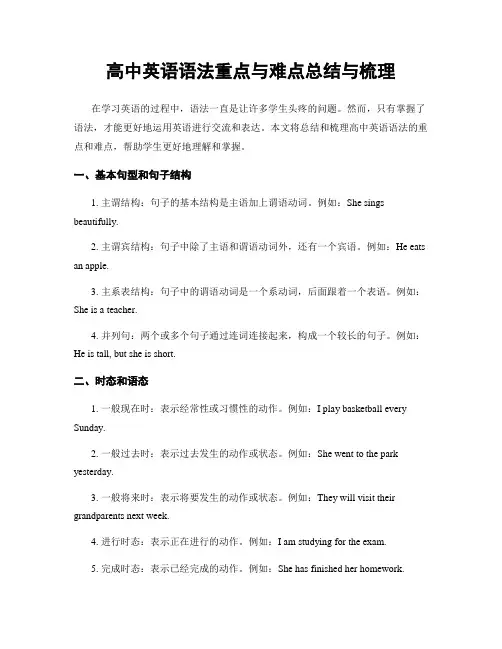
高中英语语法重点与难点总结与梳理在学习英语的过程中,语法一直是让许多学生头疼的问题。
然而,只有掌握了语法,才能更好地运用英语进行交流和表达。
本文将总结和梳理高中英语语法的重点和难点,帮助学生更好地理解和掌握。
一、基本句型和句子结构1. 主谓结构:句子的基本结构是主语加上谓语动词。
例如:She sings beautifully.2. 主谓宾结构:句子中除了主语和谓语动词外,还有一个宾语。
例如:He eats an apple.3. 主系表结构:句子中的谓语动词是一个系动词,后面跟着一个表语。
例如:She is a teacher.4. 并列句:两个或多个句子通过连词连接起来,构成一个较长的句子。
例如:He is tall, but she is short.二、时态和语态1. 一般现在时:表示经常性或习惯性的动作。
例如:I play basketball every Sunday.2. 一般过去时:表示过去发生的动作或状态。
例如:She went to the park yesterday.3. 一般将来时:表示将要发生的动作或状态。
例如:They will visit their grandparents next week.4. 进行时态:表示正在进行的动作。
例如:I am studying for the exam.5. 完成时态:表示已经完成的动作。
例如:She has finished her homework.6. 被动语态:表示动作的承受者在句子中作主语。
例如:The letter was written by him.三、从句和复合句1. 名词性从句:在句子中充当名词的成分。
例如:I believe that he is honest.2. 定语从句:在句子中充当定语的成分。
例如:The book that I borrowed from the library is interesting.3. 状语从句:在句子中充当状语的成分。
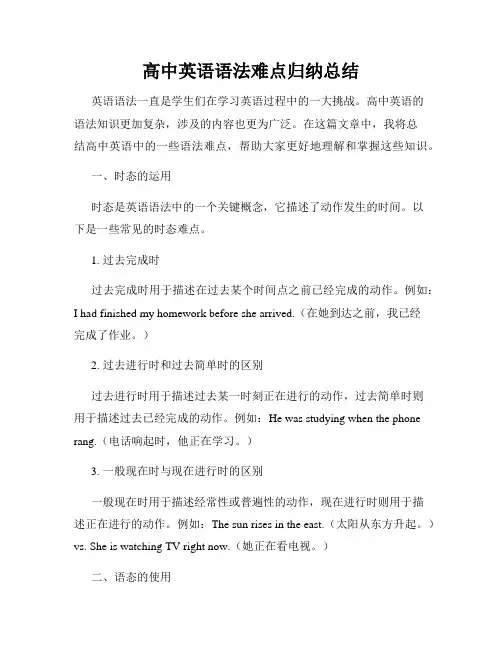
高中英语语法难点归纳总结英语语法一直是学生们在学习英语过程中的一大挑战。
高中英语的语法知识更加复杂,涉及的内容也更为广泛。
在这篇文章中,我将总结高中英语中的一些语法难点,帮助大家更好地理解和掌握这些知识。
一、时态的运用时态是英语语法中的一个关键概念,它描述了动作发生的时间。
以下是一些常见的时态难点。
1. 过去完成时过去完成时用于描述在过去某个时间点之前已经完成的动作。
例如:I had finished my homework before she arrived.(在她到达之前,我已经完成了作业。
)2. 过去进行时和过去简单时的区别过去进行时用于描述过去某一时刻正在进行的动作,过去简单时则用于描述过去已经完成的动作。
例如:He was studying when the phone rang.(电话响起时,他正在学习。
)3. 一般现在时与现在进行时的区别一般现在时用于描述经常性或普遍性的动作,现在进行时则用于描述正在进行的动作。
例如:The sun rises in the east.(太阳从东方升起。
)vs. She is watching TV right now.(她正在看电视。
)二、语态的使用语态是描述动作的主语与受事者之间的关系。
以下是一些常见的语态难点。
1. 被动语态的构成被动语态由助动词“be”加上动词的过去分词构成。
例如:The book was written by Mark Twain.(这本书是马克·吐温写的。
)2. 及物动词和不及物动词在被动语态中的使用及物动词可以转换为被动语态,而不及物动词则不能。
例如:He was given a present by his friend.(他朋友送给了他一件礼物。
)vs. She danced gracefully.(她跳舞跳得优美。
)三、虚拟语气的运用虚拟语气用来表示假设、愿望或建议等非真实的情况。
以下是一些常见的虚拟语气难点。
高中英语语法难点解析高中英语语法是学习英语的重要组成部分,也是许多学生感到困惑的地方。
本文将从几个常见的语法难点出发,进行解析和讲解,帮助学生更好地理解和掌握。
一、时态的使用时态是英语语法中一个重要的难点,尤其是对于非母语者来说。
常见的时态有一般现在时、一般过去时、一般将来时等。
它们的使用需要根据句子的语境来决定。
例如,一般现在时用于表达经常性的动作或事实,如“I go to school every day.”(我每天去学校)。
一般过去时则用于过去发生的动作或状态,如“I watched a movie last night.”(昨晚我看了一部电影)。
一般将来时用于表达将来的动作或计划,如“I will visit my grandparents next week.”(下周我将去看望我的祖父母)。
二、被动语态的构成和使用被动语态是另一个常见的语法难点。
被动语态的构成是由“be + 过去分词”组成,用于强调动作的承受者而非执行者。
例如,主动语态的句子“I clean the room every day.”(我每天打扫房间)可以转换为被动语态的句子“The room is cleaned every day.”(房间每天被打扫)。
在被动语态中,动作的执行者变为句子的主语,而原来的主语则变为介词“by”的宾语。
被动语态的使用可以使句子更加客观和正式,尤其在科技、新闻等领域中常见。
但需要注意的是,有些动词无法构成被动语态,如“enjoy”、“like”等。
三、虚拟语气的用法虚拟语气是高中英语语法中的一个复杂难点,它用于表达与事实相反或假设的情况。
虚拟语气的构成和使用需要根据句子的结构和语境来决定。
例如,虚拟语气常用于条件句中,表示与现实相反的假设情况。
如“If I were you, I would study harder.”(如果我是你,我会更加努力学习)。
在这个句子中,使用了虚拟语气的形式“were”,表示与现实相反的情况。
高中英语语法重点与难点归纳总结Introduction英语语法是学习英语过程中非常重要的一部分,对于高中学生来说,掌握语法规则和理解语法难点是提高英语综合能力的关键。
本文将对高中英语语法的重点和难点进行归纳总结,帮助学生更好地掌握英语语法知识。
一、基础语法知识1. 词类1.1 名词:用途、单复数、所有格等1.2 代词:人称代词、物主代词、反身代词等1.3 动词:时态、语态、不规则动词等1.4 形容词和副词:比较级、最高级、程度副词等1.5 介词:固定搭配、表示位置和方向等1.6 连词:并列连词、从属连词等2. 句子成分和句型2.1 主语和谓语:句子的核心部分2.2 宾语和宾语补足语:及物动词和少数不及物动词的完整表达2.3 表语和定语:对主语或宾语进行补充说明2.4 状语:修饰动词、形容词或副词的词组2.5 并列句和复合句:不同类型的句子结构及连接方式二、语法重点1. 时态和语态1.1 一般现在时:陈述事实、客观真理等1.2 现在进行时:表示正在进行的动作1.3 一般过去时:过去发生的动作或状态1.4 过去进行时:过去某一时间段内正在进行的动作1.5 一般将来时:未来发生的动作或存在的状态1.6 被动语态:强调动作的承受者而不是执行者2. 名词和代词2.1 可数名词和不可数名词:数量表达、单位转换等2.2 物主代词的使用:指示所有关系2.3 反身代词的使用:强调动作的自身承受者3. 冠词和形容词3.1 不定冠词和定冠词:特指或一般性描述3.2 形容词的用法:修饰名词、修饰人或物的特征等4. 副词和介词4.1 副词的比较级和最高级:程度或范围的描述4.2 介词的使用:表示方向、位置或时间关系等三、语法难点1. 条件句和虚拟语气1.1 条件句的种类和用法:一般条件句、真实条件句、虚拟条件句等1.2 虚拟语气的构成和用法:与现在事实相反、与过去事实相反等2. 定语从句和状语从句2.1 定语从句的引导词和使用:关系代词和关系副词的区别2.2 状语从句的种类和用法:时间、原因、条件、方式等3. 倒装和强调句3.1 部分倒装和完全倒装:句子结构的变换3.2 强调句的构成和用法:强调句子中的某一成分结论本文对高中英语语法的重点和难点进行了归纳总结。
高中英语语法知识点总结高中英语语法知识点总结语法是英语里面最难去也是最重要的一部分,升上高中,我们要学习和掌握的语法知识变得更多更难了。
下面是店铺为大家整理的高中英语语法知识归纳,希望对大家有用!高中英语语法知识归纳名词性从句重难点1. 在名词性从句中,疑问句要用陈述句的语序。
例如:①Can you make sure ____the gold ring ?(MET90)A.where Alice had put D.where has Alice put2. 动词 doubt 用在疑问句或否定句中,其后宾语从句常用 that 作连接词;用在肯定句中,连接词用 whether 或 if 皆可,而不用 that。
3. 否定转移问题。
①将think, believe, suppose, expect, fancy, guess, imagine等动词后面跟宾语从句时否定转移我想我并不认识你。
我相信他不回来。
We dont expect he will come tonight , will he ?注意:若谓语动词为hope,宾语从句中的否定词不能转移。
I hope you werent ill. 我想你没有生病吧。
②将seem, appear 等后的从句的否定转移看来他们不知道往哪去。
看来我们明天不会碰上好天气。
4. 主谓一致问题。
. .5. 语气问题① 在含有 suggest , order , demand , propose , command , request , insist, desire, require, advise 等表示要求、命令、建议、决定等意义的动词后,that从句常用“should+ 动词原形”的结构我建议我们应该立刻出发。
② 在It is +过去分词+that的主语从句中 decided,demanded,desired,insisted,ordered,proposed,suggested,recommended,requested, required等。
高中英语语法难点归纳总结大全高中英语语法是英语学习过程中的一大难点,对于许多学生来说是一座难以逾越的高山。
为了帮助学生更好地掌握高中英语语法,本文将对高中英语语法难点进行归纳和总结,提供一份完整的高中英语语法难点大全供学生参考。
一、时态的使用1. 一般现在时:用于叙述客观事实、习惯性动作和普遍真理。
例如:The sun rises in the east.2. 一般过去时:用于叙述过去发生的事情或存在的状态。
例如:I studied English yesterday.3. 一般将来时:用于表示将来发生的动作或存在的状态。
例如:I will go to the party tomorrow.二、非谓语动词的用法1. 动名词:用于作主语、宾语、表语、定语和状语等。
例如:Swimming is my favorite sport.2. 不定式:用于表示动作的目的、结果、原因等。
例如:I want to learn how to play the guitar.3. 分词:用于形容词性、副词性或独立主格等。
例如:The broken window needs to be fixed.三、从句的结构与引导词1. 定义从句:用于对主句进行解释、说明。
例如:The book that you gave me is very interesting.2. 时间状语从句:用于表示时间的先后。
例如:I will call you when I arrive home.3. 条件状语从句:用于表示条件。
例如:If it rains tomorrow, we will stay at home.四、虚拟语气的用法1. 虚拟条件句:表示与事实相反的假设或愿望。
例如:If I were you, I would study harder.2. 虚拟假设句:表示与事实相反的假设或推测。
例如:He speaks English as if he were a native speaker.五、名词性从句的用法1. 主语从句:用作句子的主语。
高中英语语法整理总结归纳高中英语语法归纳总结介词I. 要点1、介词和种类(1) 简单介词,常用的有at, in, on, about, across, before, beside, for , to, without等。
(2) 复合介词,如by means of, along with, because of, in front of, instead of等。
2、介词和其他词类的习惯搭配关系(1) 和动词的搭配,如agree with, ask for, belong to, break away from, care about等。
(2) 和形容词的搭配,如afraid of, angry with, different from, good at(3) 和名词的搭配,如answer to , key to, reason for, cause of, visit to等.3、介词短语可以有自己的修饰语,这种修饰语通常有right, just, badly, all, well, directly, completely等少数几个副词。
如:He came right after dinner.He lives directly opposite the school.4、某些介词的意义与用法举例(1) at, on, in(表时间)表示时间点用at,如at four oclock, at midnight等;表示不确定的时间或短期假日也用at,如at that time, at Christmas等。
指某天用on, 如on Monday, on the end of November, 指某天的朝夕用on,如on Friday morning, on the afternoon of September 1st 等。
指长于或短于一天的时段用in,如in the afternoon, in February, in Summer, in 1999等。
名校高考高中英语语法难点独立主格结构独立主格结构主要用于描绘性文字中,其作用相当于一个状语从句1.独立主格结构作时间状语When it stopped raining, we come back to the place immediately.省略连词,谓语动词变成Ving:it stopping raining, we come back to the place immediately.雨停了之后,我们立即返回到这个地方。
2.独立主格结构作条件状语If you study harder, you would make progress.省略连词,谓语动词变成Ving:you studying harder, you would make progress.如果你再努力一些,会有进步的。
2.独立主格结构作原因状语Because it was cold outside, she stayed inside all day long.省略连词,谓语动词变成Ving:it being cold outside, she stayed inside all day long.因为天气寒冷,她一整天都待在屋里。
3.独立主格结构作伴随状语As the wind howled , she walked fast to the bus station.省略连词,谓语动词变成Ving: The wind howling , she walked fast to the bus station.狂风怒吼,她飞快地向公交车站走去。
通过以上几个例子我们可以发现独立主格结构作状语时,其从句主语和主句主语不一致;而非谓语动词作状语,逻辑主语须与主句主语保持一致。
As引导限制性定语从句@As引导限制性定语从句中,as 多和such或the same连用,构成such....as结构(“such+an+adj. +名词+as. . . ”或“such+adj. +名词(复数或不可数)+as. . . ”)或者the same....as结构用法,as既可以指代人,也可以指代物1.as指代人,在定语从句中作主语Such writers as were invited to attend are very creative.那些应邀出席的作家都极富创造力。
几个高中英语语法难点的用法及相互联系
作者:李新宇
来源:《课程教育研究》2017年第23期
【摘要】高中英语学习是学生学习和考试过程中的关键组成部分,高中英语语法的学习也存在较多的难点还有英语语法,这些知识点之间是相互联系的,也有一定的区分性,学生在学习过程中还需要对这些要点进行关注。
以下从分词做状语和从句作状语的过程中对语法的难点和用法进行分析和探索。
【关键词】高中英语语法难点用法相互联系
【中图分类号】G633.41 【文献标识码】A 【文章编号】2095-3089(2017)23-0129-01
高中英语有几种语法的要点,其中非限制性定语从句还有状语从句非常突出,这些都是语法学习中的难点,学生很难有正确的理解。
以下就对此进行多个方面的分析,对几种语法的难点和基本用法进行互相关联的研究。
一、分词作状语
Having found a hotel, we looked for somewhere to have dinner.该句子可以翻译成为,“在找好旅馆之后,我们就去找吃饭的地方。
”在这个句子当中, ed是分析状语的情况,其中所表示的目的的方式,ed分词表示的是被动性的完成动作,并且也是逻辑主语的主要部分,主语是we, Having found a hotel,在这里寻找的主语句子中是被动性的关系,是句子的主语。
ed分词之前也有相应的连带词,在学习中经常会有when,though以及although,as等等,例如,Even if you come to me,I don’t want to go shopping with you.即使你来找我,我也不去跟你逛街。
Ice cream will become juice when heated.雪糕加热之后会变成果汁。
在这其中,ed 就是分词的逻辑主语已经成为句子的主语,都变成被动关系。
值得关注的是分词的逻辑性主语和句子的主语存在主动性的关系,因此需要使用ing作分词。
Walkking through the mountain we can see the beautiful scenery.当我们走过这座山就能够发现美丽的风景。
在这句子当中ing分词和句子的主语形成了主动性的关系,从此可以看见,分词当状语,逻辑主语就是句子的主语,这样就能够判断出其中存在的主动和被动关系,分词之前还有连带词。
二、从句作状语
A lot of people are attracted by the landscape, human migration in China.这个句子可以扩展成为主从复合句,变成As they are attracted by the landscape, human a lot of people are migration in China,从这两个句子的对比中能够看到状语从句被省略,这里也省略了主语还有基本操作词be[1]。
(I was) walking, when I was listening to some songs.
If () work carefully you will be successful.
从这两个句子当中都可以变成是状语从句。
只是形式上是不同的,使用even if 以及when 还有though等等。
状语从句当中如果和从句主语以及主句的主语是可以联系在一起的,那么就是可以省略的,主语和操作词be,若是主语从句的主语不一样就能够形成独立的结构。
两个句子结构的变化形式能够让学生掌握一定的分词,这也是基本的语法从句,有利于对非限制性定语从句进行多方面的理解,还有状语从句等等。
从此可以看到英语在发展的过程当中已经形成了非常完整性的语法体系,这些语法学生要想更好的掌握就可以通过自己的学习还有了解不断的摸索,提升对句子的感知能力,只有加强学习才能够对句子有更多的分析,提升句子的掌握能力[2]。
三、结语
综上所述,本文对几个高中英语语法难点的用法及相互联系进行了分析和研究。
英语学习在高中是非常关键和重要的一部分,因此在以后的学习过程中还需要对此进行强化,不断的提升学生英语难点感知能力,提升学生的学习成绩。
参考文献:
[1]刘云.构建新课程背景下高中英语语法高效课堂——以虚拟语气在条件状语从句中的基本用法为例[J].都市家教(下半月),2013,22(7):153-153.
[2]谢伟峰.浅谈高中英语写作中状语从句的错误原因和解决[J].读写算(教育教学研究),2015,11(34):228-228.
作者简介:
李新宇(1969年7月-),女,汉族,内蒙古赤峰市人,大学本科,高中英语教师,中学一级教师,研究方向为高中生英语思维能力的培养。